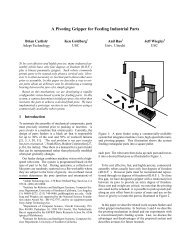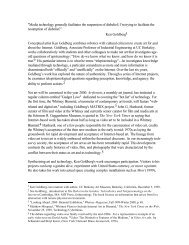“Are We There Yet?” Visual Tracking of Visitors ... - Ken Goldberg
“Are We There Yet?” Visual Tracking of Visitors ... - Ken Goldberg
“Are We There Yet?” Visual Tracking of Visitors ... - Ken Goldberg
You also want an ePaper? Increase the reach of your titles
YUMPU automatically turns print PDFs into web optimized ePapers that Google loves.
<strong>“Are</strong> <strong>We</strong> <strong>There</strong> <strong>Yet</strong>?<strong>”</strong> 11<br />
Fig. 4. Probabilistic Foreground Segmentation and <strong>Tracking</strong> Pipeline. Upper Left: Raw<br />
image. Lower Left: Posterior probability image. Lower Right: Filtered and thresholded<br />
posterior image. Upper right: Bounding boxes <strong>of</strong> tracked foreground objects and annotated<br />
confidence levels.<br />
unique color. <strong>We</strong> define a lifting operation L : C → F ⊂ Rq3 by generating<br />
a unit vector on the axis corresponding to the input color. The set F is the<br />
“feature set,<strong>”</strong> representing all unit vectors in Rq3. Let fij(k) = L( Îij(k)) ∈ F be<br />
a feature (pixel color) observed at time k. Of the T observed features, select the<br />
Ftot ≤ Fmax most recently observed unique features; let I ⊂ {1, 2, . . . T }, where<br />
|I| = Ftot, be the corresponding time index set. (If T > Fmax, it is possible that<br />
Ftot, the number <strong>of</strong> distinct features observed, exceeds the limit Fmax. In that<br />
case, we throw away the oldest observations so Ftot ≤ Fmax.) Then, we calculate<br />
an average to generate the initial histogram: ˆ Hij(T ) = 1 <br />
Ftot r∈I fij(r). This<br />
puts equal weight, 1/Ftot, in Ftot unique bins <strong>of</strong> the histogram.<br />
2.3 Bayesian Inference<br />
<strong>We</strong> use Bayes’ Rule to calculate the likelihood <strong>of</strong> a pixel being classified as<br />
foreground (F) or background (B) given the observed feature, fij(k). To simplify<br />
notation, let p(F |f) represent the probability that pixel (i, j) is classified as<br />
foreground at time k given feature fij(k). Using Bayes’ rule and the law <strong>of</strong> total<br />
probability,















